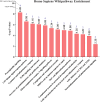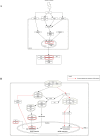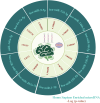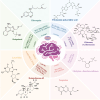A bioinformatic analysis to systematically unveil shared pathways and molecular mechanisms underlying monkeypox and its predominant neurological manifestations
- PMID: 40673003
- PMCID: PMC12263605
- DOI: 10.3389/fcimb.2025.1506687
A bioinformatic analysis to systematically unveil shared pathways and molecular mechanisms underlying monkeypox and its predominant neurological manifestations
Abstract
Background: Monkeypox (MPOX) is a zoonotic disease caused by the MPOX virus (MPXV). MPOX resurfaced globally in May 2022, spreading throughout six WHO regions, resulting in nearly 87,000 cases and 112 deaths. Clinical symptoms include swollen lymph nodes, fever, joint pain and several neurological complications such as headache, encephalitis, myalgia, fatigue, photophobia and seizures. Despite these manifestations, the precise mechanisms of MPXV's neurotropism remain elusive. This study aimed to explore the genetic underpinnings of MPOX-related neurological manifestations, including headache, myalgia, fatigue, and photophobia, using advanced bioinformatics tools.
Methods: Data were sourced from the GeneCards database, which is an integrated database of human genes. Genes linked to MPOX and its neurological manifestations were identified and cross-referenced to uncover shared genes between these conditions. Network visualization was created using STRING, followed by topological analysis in Cytoscape to identify key genes based on degree and betweenness centrality. Functional enrichment analysis through ToppGene provided insights into molecular functions, biological processes, and cellular components associated with these target genes. Pathway analysis was performed using WikiPathways, and cell-type-specific enrichment was conducted using Enrichr. Additionally, we predicted functional microRNAs using mirTarbase and identified potential drug candidates via the Stitch database.
Results: We identified 32 MPOX-associated genes and a large set of neurological manifestation-related genes. Ten hub genes, including CD55, CXCL1, NFKB1, CXCL8, CD4, IL6, MX1, CFH, KLRK1, and CD46 were shared between MPOX and its neurological manifestations. Five novel genes, including CFHR3, C5AR1, C3AR1, IFNA2, and CXCL3 were predicted to be associated with MPOX and its neurological complications. Gene ontology analysis highlighted biological processes such as immune regulation, viral life cycle, and lymphocyte activation, while pathway enrichment identified critical signaling mechanisms like prostaglandin signaling, toll-like receptor 4 (TLR4) signaling, complement activation, and neuroinflammation. Moreover, cell types such as T-helper cells, natural killer cells, and microglia were found to be significantly impacted by MPOX and its frequent neurological complications. We identified 11 key microRNAs associated with MPOX-neurological manifestations and repurposed eight potential drugs, offering promising therapeutic strategies.
Conclusion: This study emphasizes the central role of the complement system, immunological responses, and inflammatory pathways in the neurological manifestations of MPOX. The identification of novel genes and predicted therapeutic targets paves the way for future research and therapeutic interventions. Experimental validation is required to confirm these findings and determine the effectiveness of the proposed treatments.
Keywords: T-helper cells; bioinformatics; drug repurposing; headache; monkeypox; myalgia; natural killer cells; photophobia.
Copyright © 2025 Barjasteh, Latifi and Sepehrinezhad.
Conflict of interest statement
The authors declare that the research was conducted in the absence of any commercial or financial relationships that could be construed as a potential conflict of interest.
Figures










Similar articles
-
Deciphering Shared Gene Signatures and Immune Infiltration Characteristics Between Gestational Diabetes Mellitus and Preeclampsia by Integrated Bioinformatics Analysis and Machine Learning.Reprod Sci. 2025 Jun;32(6):1886-1904. doi: 10.1007/s43032-025-01847-1. Epub 2025 May 15. Reprod Sci. 2025. PMID: 40374866
-
Elucidating the Mechanism of Xiaoqinglong Decoction in Chronic Urticaria Treatment: An Integrated Approach of Network Pharmacology, Bioinformatics Analysis, Molecular Docking, and Molecular Dynamics Simulations.Curr Comput Aided Drug Des. 2025 Jul 16. doi: 10.2174/0115734099391401250701045509. Online ahead of print. Curr Comput Aided Drug Des. 2025. PMID: 40676786
-
Therapeutics for treating mpox in humans.Cochrane Database Syst Rev. 2023 Mar 14;3(3):CD015769. doi: 10.1002/14651858.CD015769. Cochrane Database Syst Rev. 2023. PMID: 36916727 Free PMC article.
-
Exploring the shared molecular mechanisms of primary hypertension and IgA vasculitis through a case report and combining bioinformatics analysis.Front Immunol. 2025 Jun 6;16:1596174. doi: 10.3389/fimmu.2025.1596174. eCollection 2025. Front Immunol. 2025. PMID: 40547031 Free PMC article.
-
Systemic pharmacological treatments for chronic plaque psoriasis: a network meta-analysis.Cochrane Database Syst Rev. 2021 Apr 19;4(4):CD011535. doi: 10.1002/14651858.CD011535.pub4. Cochrane Database Syst Rev. 2021. Update in: Cochrane Database Syst Rev. 2022 May 23;5:CD011535. doi: 10.1002/14651858.CD011535.pub5. PMID: 33871055 Free PMC article. Updated.
References
MeSH terms
LinkOut - more resources
Full Text Sources
Medical
Research Materials
Miscellaneous

